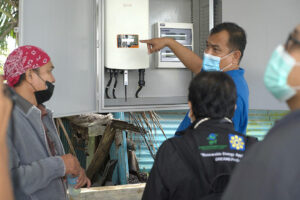NGA 911 seeks to improve LGUs’ emergency response capabilities

NEW GENERATION Advanced 911 (NGA 911), a cloud-based technology from the United States, is set to expand its partnerships with local government units (LGUs) in the Philippines to help modernize their emergency response capabilities.
NGA 911 Chief Financial Officer Ishka Villacisneros said the company is inking partnerships with different localities in the Philippines as they aim to help make the country’s emergency response most advanced in the region.
“The goal here is to propagate this technology across all LGUs,” Ms. Villacisneros said in an interview last week.
NGA 911 is expected to deploy its system in Morong, Rizal, its first partner LGU in Asia, before the end of the year.
Aside from Morong, the technology is also expected to be deployed in Alaminos, Pangasinan.
NGA 911 uses Internet Protocol technology to facilitate communication between callers and emergency responders, enabling the transmission of voice, text, and video messages through mobile devices and even via social media applications.
Its services include the training of staff, hardware, and software tools, and maintenance of the system.
The technology will connect fire, police, and medical authorities to enable quicker response time, Ms. Villacisneros said.
“When residents of Morong call 911, they won’t go through the national line anymore —they will be directly connected to Morong emergency response team,” she said.
Extended call wait times on the national 911 hotline are due to the influx of spam calls that are hard to filter, Ms. Villacisneros said, adding this can be done by NGA 911.
Instead of having different emergency hotlines for each locality, there is a need to have a unified emergency number for all LGUs, she said.
“The problem in the Philippines is that when you’re in Quezon City and then move to Makati, the emergency numbers often change… So our main goal is to unify the emergency number with the international standard 911,” she added.
The cost of implementing an advanced 911 system in cities and municipalities is not as expensive as it may sound, Ms. Villacisneros said.
Morong is currently classified as second-class, and we also have a fourth-class municipality in our pipeline. If these LGUs can, highly urbanized cities also can,” she said.
“You don’t really need to construct a large building because all the equipment is in the cloud. If you were to see our setup, it’s just about the size of two DVD players,” Ms. Villacisneros added.
Cloud-based technology allows the system to operate even during a calamity, she said.
“With the Philippines having numerous islands and facing calamities, relying on a single system can be risky. But here, we have a backup system. For instance, if one center gets flooded, all systems remain connected,” she added.
“If the provincial center sees municipal centers go down, they can step in, and if needed, even the national center can step in. The province can monitor all their LGU centers seamlessly,” Ms. Villacisneros said. — Jomel R. Paguian




